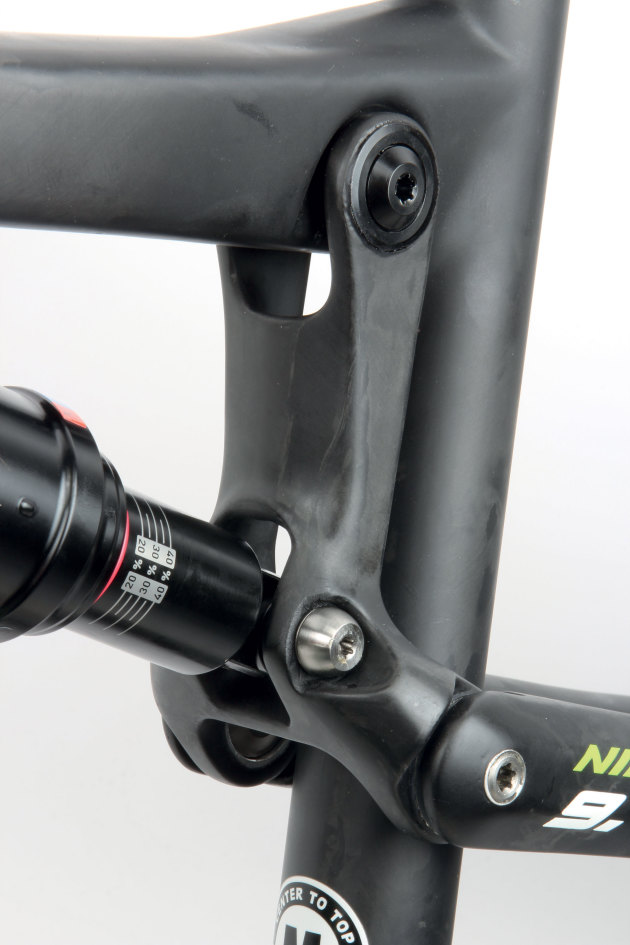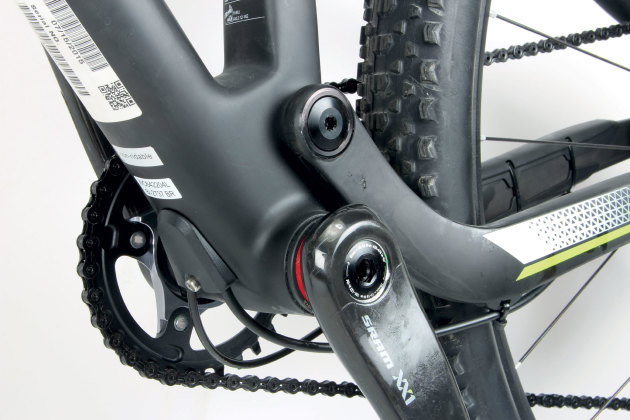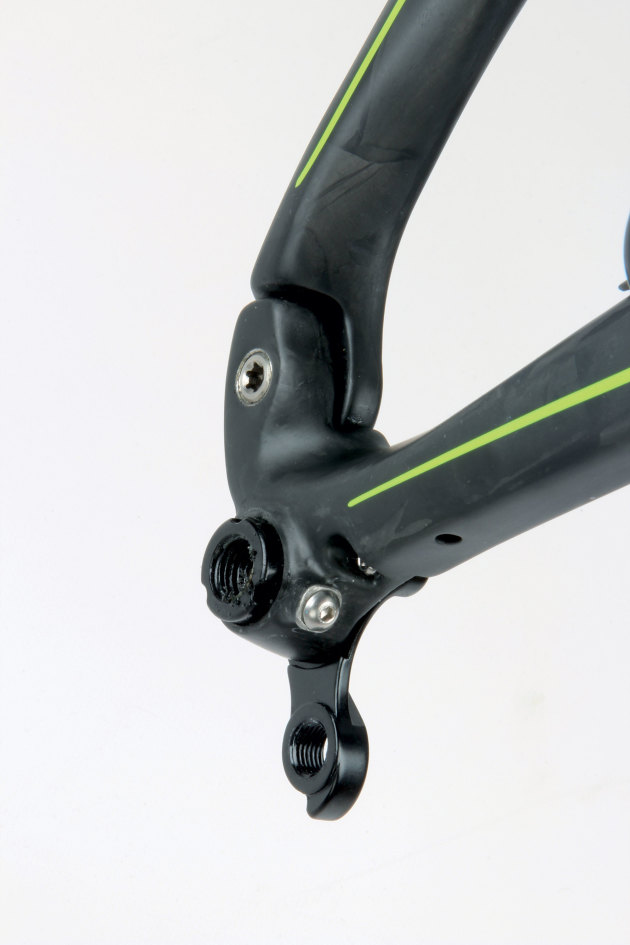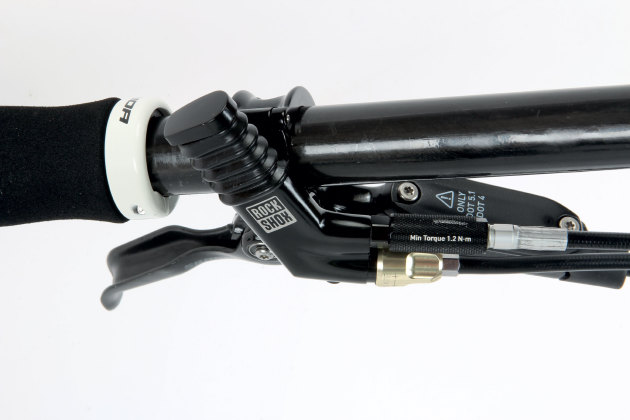Merida Ninety Six Team
For 2016 the Ninety Six returns to the Merida range, once again filling the role as their prime XC race dually. The original Ninety Six was a superlight 26-inch racer but the 2016 version will be offered with eight 27.5 or 29-inch wheels. Like a number of other manufacturers, they’ll vary the wheel size to match the rider.
In this case, the small frame will come with 27.5 wheels while the large and extra-large will be 29er-only. The medium size will come in both options, so riders can choose according to their preference; 27.5 for lighter, stronger wheels with snappier acceleration and handling, or 29 inch wheels for their roll-over ability and momentum preservation once up to speed.
With the bigger wheels, the Ninety Six has 96mm of rear wheel travel (as you’d expect) but the 27.5 bikes offer 110mm of travel. Merida says the added travel compensate for the smaller wheels, improving traction and smoothing the ride.
Regardless of size, all of the Ninety Six bikes run a 100mm travel fork.
Speaking of options, this platform will be offered at three different levels. We threw our leg over the range-topping Team model with the 29-inch wheel option, as this was the first model from the Ninety Six range to hit our shores. It features a totally blinged out build with a platinum price tag to match; you can kiss goodbye to $10K for this bad boy! You’ll find the same frame geometry, suspension kinematics and styling on the two more affordable models.

At $4,799 the Ninety Six XT gets a full Shimano XT 2X11 groupset and Fox ‘Performance’ level suspension. Where the top-flight Team frame uses high-modulus carbon throughout, the XT uses mid-modulus carbon in the main frame with an alloy rear end. The base model Ninety Six 800 goes for $3,099. It’s also Fox equipped with an SLX level spec and an all-alloy version of the Ninety Six frame. Our prime focus here is the Team bike but many aspects of its performance will transfer across to the more realistically priced models (we’ll highlight the main points of difference as we go).
So what do you get for $9,999? Well the spec leaves little to be desired and it’s more or less what their team riders would be on for a World Cup race. First up you get their CF5 frame, and gee it’s a sweet piece of work. Just about every part of the frame is made from carbon; the front triangle, seat and chainstays, dropouts—even the top tube mounted swing link is made from this fantastic plastic. The bolt hardware is either alloy or titanium and the raw carbon frame finish saves precious grams too.
Weightless Wonder
We often read claims of superlight sub-2kg XC frames but there’s usually a catch; like they weighed an unpainted pre-production XXS frame with no shock and no pivot hardware. In this case the Ninety Six meets the claims; our sample weighed just 1,965g for the frame and shock (it was actually a few grams lighter than Merida states). As impressive as the weight is, we couldn’t help feeling a little disappointed that you’ll only get this amazing frame on the top-flight Team build.

Both of the more affordable models incur a sizable weight penalty, and that’s before you factor in the heavier component spec. With its mid-modulus front end, alloy rear and carbon swing-link, the second-tier CF2 frame is approximately 500g heavier than the Team model. That means you’re looking at a 2,500g frame on the XT equipped bike; that’s still okay for an XC race frame but nothing to shout about. Skip to the all alloy 800 model and the frame jumps to 2,900g which is more trail bike weight than XC racer.
In keeping with current trends, all of the cables and hoses are routed internally. It’s well thought out too, as there’s a large window down tube near the bottom bracket to make cable replacement relatively easy. Fitting or removing the rear brake is still pretty involved, as you need to disconnect the hydraulic line, but on the whole Merida is easy to live with. Once you’ve passed a cable through the frame, the plastic covers lock everything down to minimise the chance of cable rattles.
While the Team bike comes with a single front chainring, there’s a removable derailleur mount and a port on the down tube that’s ideal for cabling up a Shimano side swing front mech. While most elite level XC riders are still holding off with height adjustable seatposts, Merida had the foresight to place a small hole at the base of the seat tube for a stealth style dropper—at least the option is there.

Bring on the Bling!
The Team drivetrain is mainly from the SRAM XX1 stable, everything except the all-black X01 cassette that is, but it’s equal to XX1 in weight and quality anyway. SRAM also looks after the stopping duties with their new Guide Ultimate brakes (see P44 for a full review). While there are lighter more XC oriented brakes, the power and control offered by the four-piston callipers added some real confidence whenever the trail pointed downhill. If anything, the larger 180mm front rotor is overkill – at least for Aussie XC racing – and a 160mm rotor would have saved a few grams (well 34g to be precise).
The finishing kit consists of mainly house brand ‘PRC’ parts. They all worked well and some of the parts were impressively light; like the 93g alloy stem, 10g carbon seatpost collar and the 167g all-carbon seatpost for example. The bars came in at 190g which isn’t overly light but at least they were 720mm wide, which is ample for XC use. Even the Prologo Nago saddle was a good choice; with titanium rails it weighs 228g but offers enough padding and flex to provide comfort on longer rides.
About the only part I’d ditch is the 80g foam lock-on grips; I didn’t find them comfortable but that’s a matter of personal preference.
DT Swiss rounds out the component selection with their XR 1501 wheelset. While they’re claimed to weigh 1,510g, the real life figure was 1,600g (that’s with the RS1 specific front hub and rim strips). That’s not light for a bike that’s billed as a World Cup racer. With a 20mm internal width, they’re also pretty narrow; that means you’re more likely to suffer tyre squirm at lower air pressures. In this application it won’t be a deal breaker, as you’re probably going to have narrower tyres, but we’d still have preferred rims in the 23-24mm range.

For the asking price we can’t help thinking that Merida could have stretched to a lighter more World Cup race worthy wheelset on their Team model, however the funds are absorbed elsewhere as we’ll explain in a minute. On the positive side, the rims have a tubeless ready inner profile and the stock Maxxis Ikon tyres aired up with minimal fuss. The DT hubs come fitted with the upgraded 36T ratchet mechanism for quicker uptake in technical riding. While they aren’t the stiffest wheels, the ride quality was good and they remained straight throughout the review where a sub-1,500g alloy wheel set would have probably needed some truing (sub-1,500g carbon would have been nice however).
Boutique Bounce
There’s something about the RockShox RS1 fork. It’s about 130g heavier than the less expensive SID World Cup fork but gee it makes the bike stand out. The massive one piece carbon upper assembly and upside down format just screams ‘look at me!’
We’ve spent plenty of time riding this exotic fork on various bikes and it is a good performer. It lacks torsional stiffness when compared to the SID but the fore/aft stiffness is streets ahead of any regular XC fork. It’s also better at sucking up the bumps when you’re hard on the brakes—right where other forks seem to bind up. For me the torsional flex wasn’t an issue but I’ve heard others complain about it. Personally I’ve never had a problem holding a line with the RS1 and I like the way it continues to soak up the hits when you’re hauling on the anchors.
Looking at it objectively however, it’s hard to justify the added cost of the RS1. Based on aftermarket pricing the RS1 sells for $2,300; that’s about $1,000 more than a SID. It’s money that could have been directed towards some lightweight carbon wheels but the end result wouldn’t have looked as cool!
A key feature of the Ninety Six is the dual remote lockout; a single button turns it from a 100mm travel dually to a fully-rigid sprint machine. The Team model uses a hydraulic button to control the RS1 and Monarch XX rear shock. Aside from the two extra hydraulic lines, it integrates neatly with the left hand Guide brake lever, and being hydraulic it’s close to maintenance-free.
The two more affordable Ninety Six models have a single button dual lockout system too, so they retain similar functionality in this regard. The Fox system is mechanical, with one lever pulling a single cable that then pairs off to either end of the bike.

Being mechanical, you may find yourself replacing the remote cables after a few rainy rides. Also, the combination of a dual lockout remote along with the left hand gear shifter makes for some very cluttered handlebars on the 2X equipped models.
Suspension Semantics
Merida’s marketing talks about the importance of the leverage ratio in determining the ride feel of the Ninety Six. It has a regressive then progressive leverage curve; the 29er starts at 2.45:1 and goes to 2.55:1 before progressively ramping up to 2.4:1 at the end of its travel. This technobabble means the suspension sinks into the sag point where it’s at its softest (around 20-25% travel) before gradually getting firmer to resist harsh bottoming. That’s the theory anyway, but we feel the variation from 2.45 to 2.55 and then 2.4 is so minimal that it’s basically a linear system. Most XC platforms tend to be linear and it works well in this application.
The travel is quite supple when the shock is open. It is more active than most race focused XC bikes, which often have their suspension tweaked to be firm initially at the expense of traction and comfort. The Ninety Six is constantly working over small bumps and it lets you focus on the important stuff—pedalling! While 100mm of travel isn’t a lot, the bike uses it well and can handle bigger hits without bottoming harshly.
The marketing material from Merida also talks about the main pivot placement and how the new platform is optimised for 1X drivetrains. With a single 32 tooth chainring the bike does pedal reasonably well. It doesn’t stiffen a lot when pedalling – again it remains active with minimal feedback through the drivetrain – but isn’t excessively soggy under foot either. If anything it would pedal with more assertiveness with a 30 tooth chainring fitted, which is a reasonable popular option on 1X equipped 29ers.
So the Ninety Six pedals efficiently enough with a 30 or 32 tooth chainring but this changes when a double ring drivetrain is fitted. Both of the 2X equipped models use a 36 tooth big ring and the larger chainring reduces the anti-squat effect when pedalling. This will lead to a softer feel when you’re hammering on the pedals. The same can be said for the 1X setup if you’re using a 34 or 36 tooth chainring.
It mightn’t be the firmest pedalling XC bike with the suspension open (especially with the 2X models) but this all changes at the press of a button. The dual-lock feature gives you a fully rigid bike in an instant, and in the right situation the benefits can be huge. No matter how effectively tuned the anti-squat qualities are on a suspension bike, there’s always some movement when you’re really driving it up a climb or kicking hard out of a turn. In the context of an out-and-out XC racer this movement is undesirable.
Flick the lockout and the Ninety Six just begs to accelerate; it encourages you to get out of the saddle and absolutely smash yourself. And with the Team bike weighing just on 10.3kg (without pedals) it has some serious get up and go. As the dual-lockout is so easy to use, you quickly get into the habit of using it all the time. The RS1 and Monarch XX combo will still move if you hit something whilst they’re locked; it’s just the suspension action is stifled by the heavy low speed compression damping.
Merida also reworked the geometry with the new Ninety Six. When compared to the outgoing Big Ninety Nine the chainstays have shrunk from 450mm on to 445mm and the bottom bracket now sits 13mm lower. The seat tube is a degree steeper (now 74 degrees) while the head tube has been trimmed a tad. Our medium frame had a stubby 100mm head tube; this along with the -17 degree stem gave the Ninety Six Team a very low front end—ideal for elite level XC racing. The lower-line models share the same frame geometry but come with a more casual -5 degree stem.

On the trail the Ninety Six proved to be really well balanced. The chainstays mightn’t be exceptionally short but the ride feel is surprisingly agile. Some of this agility would be due to the low weight of our Team level test bike but the compact 1,120mm wheelbase (medium), well-proportioned reach and short(ish) 80mm stem also play a role.
Even with the downward sloping stem you remain centred on the bike and it doesn’t have the nervous ‘over the front’ feel that some XC bikes do. While I wouldn’t describe it as out-and-out playful, it’s not a dull handling wagon wheeler, in fact most of the time I forgot it was a 29er—the Ninety Six just feels natural.
More than just a XCO race tool, the Ninety Six is a great bike for any fast XC-style riding; from marathons to racing your buddies on the weekend. If it wasn’t for the distinctly race oriented cockpit on the Team model, it could happily pass as a fast trail dually. There’s enough travel to provide a major advantage over any XC hardtail whenever the trail turns rough or points downhill, and when you punch the lockout button, you’ll feel like you’ve got a rocket strapped to your behind! Some of this eagerness will undoubtedly be lost on the more affordable bikes (mainly due to the added weight) but the handling and suspension performance should remain relatively unchanged. In the top-flight Team mode, the Ninety Six is your instant ticket to the feel and speed of a World Cup racer—all you need is the legs and lungs to do it justice!
Thumbs Up
Featherweight yet stiff and solid frame
Dual suspension lock for race situations
Balanced handling and agility
Thumbs Down
You’ll need to sell a kidney to buy the Team model
The affordable models get much heavier frames
Lighter wheels would have been nice
Specifications
Frame CF5 High Modulus Carbon
Shock RockShox Monarch XX 96mm Travel
Fork RockShox RS1 100mm travel
Headset FSA Semi-Integrated
Handlebars PRC Team Carbon Flat 740mm
Stem PRC Team alloy 80mm
Shifter SRAM X01
Front Derailleur N/A
Rear Derailleur SRAM XX1
Cassette SRAM X01, 10/42 11-speed
Chain SRAM XX1
Cranks SRAM XX1 32 tooth
Bottom Bracket SRAM PF BB30
Pedals N/A
Brakes SRAM Guide Ultimate
Wheels DT Swiss XR 1501
Tyres Maxxis Ikon 2.2
Saddle Prologo Nago EVO
Seatpost PRC Team Full-Carbon
Weight 10.3kg without pedals (Medium frame 1,965g)
Available Sizes S, M (tested) L and XL
Price $9,999
Distributor Advance Traders 1300 361 686 / www.merida.com.au










